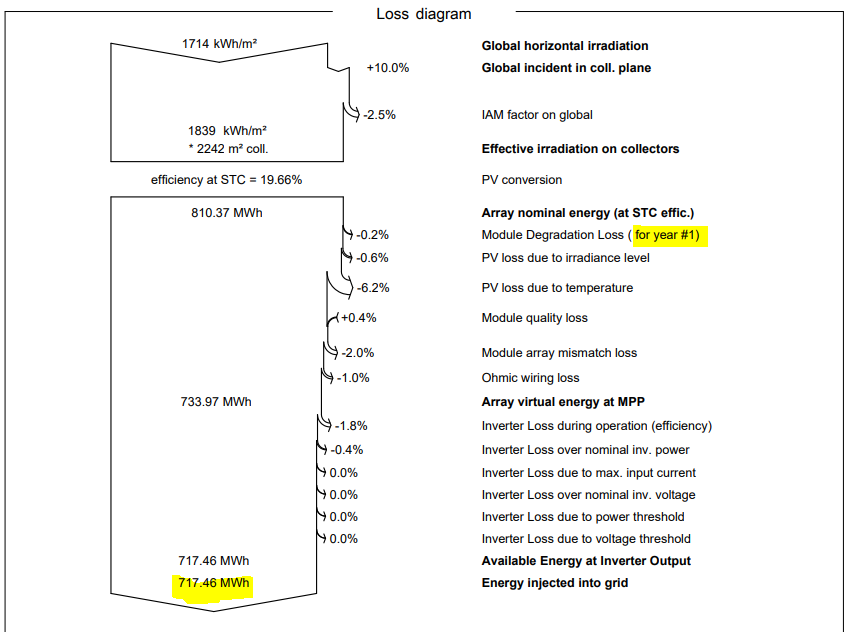-
Posts
298 -
Joined
-
Last visited
Everything posted by Linda Thoren
-

Define power sharing with less number of mppt inputs used
Linda Thoren replied to faculuc's topic in Simulations
Hello, In general, you can define multiple MPPTs per sub-array (as long as you have a multiple between the number of strings and MPPT inputs). Indeed you have this constraint in the current version that you can not have empty MPPT inputs. To get around the constraints in PVsyst, you could modify the number of MPPTs in the OND file, though this might impact other behaviors of the inverter and you should adjust all the parameters to correspond to the use-case you are referring too. The following youtube video further explains the MPPT and Power sharing: -
Hi, No it is today not possible to include that in the original simulation. If you choose to simulate both sides as front sides, that can indeed be simulated in the same variant (with the proposed work around of modifying the .PAN files) You are right, the thermal losses only consider front side irradiance, we will look into this. Kind regards
-
Hello Luis Zimmermann, In PVsyst, the beam and diffuse components and the rear side of a vertical bifacial PV system are calculated similarly as on the front side, by computing the integral of the visible sky. For the rear side irradiance, this is done using a 2D intersection method, same as the "unlimited shed" field type. If the layout is done in the 3D scene, the visible sky is instead in 3D. With bifacial systems, the view factor model also estimates the contribution of ground reflection to the front and rear side (not considered in mono facial simulations).
-
Hello, In the economic evaluation, you can include hourly tariffs to assess the financial benefits of a peak shaving strategy. You can in the peak shaving strategy specify the hours when you allow for the battery to discharge and inject to the grid and calculate the revenue based on the corresponding tariff rates. However, the system does not work in reverse—economic data cannot be used as an input to control battery storage behavior.
-

Grid-connected PV plant with battery storage and no self consumption
Linda Thoren replied to Vasil Janevski's topic in How-to
Hello, Indeed the peak shaving is not design for this exact purpose. With the peak shaving strategy you will only store the energy above the set grid limitation. Setting a lower grid limitation will allow to charge the batteries and then you can set the specific hours for when you want to discharge the batteries. Indeed the discharge of the batteries will also be limited to the set grid limitation threshold. -
If you have less production, there will be less energy to charge the battery with, no matter the size of the battery. But it could indeed also depend on the charging and discharging power
-
Hello, The system is not completely the same before the battery (you have a 9.2% loss to the right compare to 2.3% to the left), thus you have less solar production to the right. Also have a look at for instance the charging and discharging power. Kind regards
-
Indeed this is a limitation of the bifacial model today. A possible workaround, is to modify the .PAN file and place two panels back to back. By creating separate modules for the front and rear—each with a bifaciality factor of 0 (and adjusted properties, e.g., lower power, no AR coating for the rear)—you could place them back-to-back in the 3D scene and simulate the system using the Module layout. This wouldn’t fully replicate real system behavior, and on clear days electrical shading losses might be underestimated due to the fact of having two panels instead of one. This in not necessary a recommendation, but could work as a test to evaluate the shadings for the backside. Otherwise, for the estimation of the electrical shading losses in general for a vertical EW system, the irradiance distribution on the rear side should be roughly as uniform as on the front. This means that, in principle, the rear mismatch factor should be set to zero, as it only accounts for additional non-uniformity on the rear. However, since PVsyst currently calculates electrical shading losses only for the front side, using the rear mismatch factor as an approximation for rear-side shading losses is reasonable. That said, determining whether 5% is an accurate value is difficult, as it depends heavily on system geometry (row height, spacing, etc.). As a first approximation, it would be best to adjust the rear mismatch factor so that its corresponding losses in the loss diagram match the electrical shading losses multiplied by the bifaciality factor.
-

Can someone please explain the diagram loss for bifacial?
Linda Thoren replied to RobSolar's topic in How-to
Hello, Indeed this is not very straightforward. The irradiance on the rear side is renormalized to the 4806872 m2 of collectors after the View Factor (1111 -73.71% -81.34% * 14897331/4806872 +15.6% +0% -9.9% results in 176). This further explained in the help page below: https://www.pvsyst.com/help/project-design/bifacial-systems/bifacial-systems-results.html -
Hi, at the moment PVsyst cannot simulate the backside irradiance for domes. Note that in general the bifacial gain of dome structures is negligible, unless they are installed very high above the ground. So your results are not really useable like this. The backside irradiation model is a 2D approximation that currently only works on single orientation rows. It does not take into account shading objects from the shading scene, as the rows of panels in the opposite orientation. Regarding the height above ground (that is defined in the unlimited 2D Model tab) and the albedo, normally it is possible to define this for each orientation if you save the definitions (clicking OK)
-

unavailability losses in the Loss diagram of report
Linda Thoren replied to ShivamPandey's topic in How-to
Hi, This is not on the road map at the moment. If you wish to have an unavailability in production loss, such as in soiling losses, you can indeed put the unavailability in the soling losses tool instead. -
Hello, Indeed if it is a grid limitation can be applied in the Energy management window, Grid power limitation, instead of modify the inverter. If the grid limit is in apparent power, note that you here can change the limit from active power to apparent power. Kind regards
-

unavailability losses in the Loss diagram of report
Linda Thoren replied to ShivamPandey's topic in How-to
Hello, Unavailability can only be defined as a time fraction, not as a direct production loss. Consequently, the impact on production will be higher if unavailability occurs during peak production hours rather than at night. If your goal is to determine production loss due to system unavailability, you will need to adjust both the time fraction and the specific timing of the unavailability to accurately reflect the desired energy loss. -
Dear Luis Zimmermann, The bifacial model in PVsyst does not consider any additional shading objects from the 3D scene for the backside irradiance, only the parameters in the Bifacial system definition is used in the simulation. Thus, to include the impact of the mounting structure, this should be estimated and put in the Structure shading factor in the General Simulation Parameters in the Bifacial system definition window. Kind regards
-

How to Apply Subhourly Clipping Loss With Hourly Meteo Data
Linda Thoren replied to kjs55's topic in How-to
Dear kjs55, Thank you for your input. PVsyst is not a weather provider, but a simulation software. Several data providers supply sub-hourly values that you are welcome to import as a custom file and apply the sub-hourly clipping correction. Kind regards -

Inquiry About PVsyst-Generated PDF Password Requirement
Linda Thoren replied to NFI's topic in Simulations
Hi, A report generated in 8.0.6 can be opened in an editor such as inDesign without a password. Kind regards -

Inquiry About PVsyst-Generated PDF Password Requirement
Linda Thoren replied to NFI's topic in Simulations
Dear NFI, Indeed, in earlier version the report was protected so that it cannot be manipulated. To use certain graphs, you can instead click "Export" and "copy to clipboard" Kind regards -
In the printed report you can include both the performance ratio and a P50/P90 evaluation, but not a performance ratio of the P90 evaluation. Kind regards
-

Necessary steps while using actual measured data for PVsyst.
Linda Thoren replied to bommu's topic in Suggestions
Hello, It is possible to import measured data through the databases window, Custom file. Choose your file, define your site and click New to construct the format file. For measured Global Inclined Irradiance, or Plane of Array Irradiance, choose the Measured global on plane variable GlPMeas and define the orientation definition and albedo. Measured POA irradiance import uses HAY transposition model. Make sure that the simulation is also performed with Hay transposition model to ensure consistent POA. You change the transposition model in the Project settings, Design conditions tab. The module temperature should be imported as the variable TArrMes - measured module temperature. If you do not have any measurements for the ambient temperature, ambient temperatures will synthetically be generated from another source and this function seems to not work correctly. When running the simulation, in the detailed losses window, thermal parameters tab, make sure you tick the option Use Measured Array Temperature and the synthetically generated ambient temperature will not be an issue for the thermal losses. Kind regards -
Hi, The output will depend on your type of system. A fixed tilted system with an optimum tilt and azimuth will peak when the GHI peak, a east west system will rather peak in the morning and evening. This is also what you see a bit with trackers with trackers with a north-south axis during months where the sun's position is relatively low. Indeed such a drastic peak in the end of the afternoon looks strange, is the irradiance data and the hourly output aligned? Do you have an have an azimuth? Is there a horizon line? To be able to analyze this in more detailed, please send your project to support@pvsyst.com Kind regards
-

Vertical panels - ground reflexion for monofacial
Linda Thoren replied to v.ming's topic in Simulations
Hi, Indeed, today the ground reflection is only considered for bifacial systems. As you say, the ground reflection for the front side can be rather significant for vertical systems. The only way to run a simulation including the ground reflection for the front side for a monofacial system today, would be to alter the PAN file (activating the bifaciality and put the bifaciality factor to 0) and run a simulation with the bifacial parameters, though everything except the ground reflection on front side will be 0 given the bifaciality factor of 0. In the example below I defined a vertical system using the unlimited sheds, facing south, 2 rows, 20m high and a pitch of 50m, to simulate a system similar to a façade mounted vertical system. -
Hi, No, the stand alone system will prioritize solar and only use the genset as a backup, thus unfortunately this is not possible to plan charging of the batteries with the genset without a direct use (and possibly waste solar produced energy in the morning if the batteries are already full and there is no direct need). The genset will ensure the recharging of batteries when the solar energy is insufficient to satisfy the user's needs.






